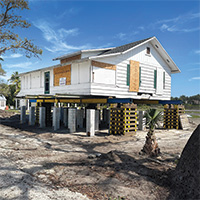 Renovated ‘Jones’ house will have new life as museum
Renovated ‘Jones’ house will have new life as museum
STORY BY STEVEN M. THOMAS (Week of June 6, 2024)
A humble cracker house built along the Jungle Trail the year Warren Harding became president is in the midst of a $1.1-million renovation that will transform it into an intimate and enlightening “interpretive center” owned and operated by Indian River County.
Five carpenters and labors are working on the Jones house this week in the summer heat, restoring original pine floors and old windows to create what will be both a museum of island history and an intellectual and emotional gateway to the ecology of the Indian River Lagoon.
“It will look remarkably like it did when the Jones family was living there,” said Wendy Swindell, the county’s conservation lands manager, who is overseeing the project.
“The frame of the house was basically in pretty good shape,” said Close Construction job superintendent Allen Payne. “It has survived however many hurricanes for more than 100 years and is still standing.”
Interesting as the house is and will be when it opens with Jones’ family artifacts, a children’s section “with exhibits just for kids,” and a wide screened porch where visitors can sit in rocking chairs watching the Indian River flow by, it pales in comparison with the man who lived in the house for 90 years.
Richard “Dick” Jones was a man who outlived history but also saved the past and had the last laugh in the end.
Every person who spoke with Vero Beach 32963 about Richard Jones used the same phrase when asked to describe him: “He was quite a character!”
Jones was born in Vero in 1919, near the end of the First World War, when the barrier island was an isolated, mosquito-bitten wilderness with patches of farmland, and he lived long enough to see the modern island we know today, with its roads, bridges, country club communities, resorts, restaurants and public beaches.
Well into the early 21st century, he remained a presence along the Jungle Trail, not a costumed theme park cast member but a true living remnant of the past, sitting in a swing by his shuttered fruit stand, greeting friends and passersby, telling tales of rum running, German submarines, giant fish and the most famous grapefruits in the world.
“He had a lot of stories – and some of them were probably true,” joked Keith Thompson, a retired mechanical engineer and businessman who lives in Island Club.
“My wife and I used to walk along the Jungle Trail starting in the early 1990s and we would stop and buy grapefruits at Dick’s fruit stand. He and his wife Mary were still producing citrus then and we got to know them quite well. He was a very interesting man.”
The ultimate homeboy, Jones lived in the small frame house now under renovation his entire life, except for a couple years during World War II when he served in the U.S. Army in North Africa, Sicily and Italy, winning two Bronze Stars.
“That fruit stand and the family pier were his life,” said former Indian River County commissioner and county historian Ruth Stanbridge.
At the same time, Jones clearly had an exuberant personality and adventurous spirit.
When he passed away on March 26, 2011, his obit described him as “a pioneer, WWII veteran, citrus grower, commercial fisherman and fishing guide.”
He was also a musician, playing guitar in an early Mel Tillis band in honkytonks and other venues around Florida, according to Stanbridge and Thompson, and served as the manager and host of the substantial pier that extends into the lagoon across from the little frame house, which, like the home, was built by his father Milton Jones.
“The Jones pier was probably the first pier on the island, and it was an important citrus shipping and trading spot,” said Stanbridge.
“Before there were bridges to the island or stores nearby, a boat that was like a floating Walmart would stop at the pier, bringing dry goods and all the things the pioneer families needed,” said Swindell.
“A.B. Michael operated the boat between Sebastian and Stuart and always stopped at Jones Pier,” Stanbridge added. “It was a very substantial dock and island people would come there to trade.”
Long after bridges linked the island to the growing mainland community, Jones pier remained a well-known stopover along the Intracoastal Waterway.
“Walter Cronkite was an annual visitor,” said Stanbridge. “He would tie up at the pier on his way down the river to Palm Beach to buy fruit and listen to Richard’s stories.
“Richard was quite a talker! You had the sense he was embellishing his stories a little bit, and you never knew quite what to believe, but it was always interesting.”
Even as he stayed home in the same peaceful, beautiful place, decade after decade, while the most transformative century in history unfolded in the distance, the world came to him.
Billy Graham, who frequented Vero from the 1950s to the 1970s, bought a fish camp nearby and Jones was his longtime fishing guide.
“Even after Graham moved away, he sent Richard a Christmas card every year. Richard showed me a stack of those cards one time,” said Thompson.
“Jungle Trail was our A1A in the 1950s,” said Stanbridge. “There was a lot of people coming and going, tourists and locals, and lots of boat traffic on the river, and Richard was always out there engaging people and getting to know them.”
Boaters made the pier a regular stop and Jones profited from his popularity. He owned the bottom of the river in front of his property and charged small fees to moor at the pier or fish in the adjacent waters to supplement his income as a farmer and guide.
By the time the 21st century rolled around, Jones may have looked to some like a mere relict, an old man the world had passed by telling tall tales by a country road, but he had his wits about him along with all his memories.
“Richard was sly,” said Stanbridge. “The county first started trying to buy and preserve that property back when I was a commissioner. He acted interested but I knew he wouldn’t sell back then. He was looking ahead, finagling for a high price.”
When he finally sold the house, pier and his remaining 16.5 acres of land to the county in 2008, he got the deal he wanted. The county agreed that the property would never be developed as a subdivision, that his family’s name would always be associated with it, and that he and his wife would be allowed to live in their home for the rest of their natural lives.
The sale price was $6,750,000 according to county records, probably more money than was in the whole county the day he was born.
So, people who met him in those last few years, sitting in his country clothes on his old swing by the shell road, watching boats and birds and water sparkling in the sun, were meeting a rich man who made staying put pay off in a big way, for his family and everyone in the county.
Mary Jones passed away just a year after the sale, in 2009. Richard followed in 2011, and the county took possession of the property that year but didn’t do anything with it for almost a decade.
In 2016, the old house was flooded by hurricane Matthew, a monster Cat-5 storm that just missed Vero Beach but still threw up the biggest storm surge in memory, a 10-foot wall of water that overflowed the lagoon and nearly washed out a stretch of A1A on the north island.
Because of that, the county’s first move when it was ready to renovate the house was to elevate it 5 feet and put new concrete piers underneath, at a cost of $468,000.
That happened in January 2023, as the rest of the property was being converted into an amazing little ecological wonderland.
Following a conceptual design created by Swindell and her boss Beth Powell, who is in charge of parks, recreation and conservation in the county, county contractors and volunteers created a salt marsh connected to the lagoon by two culverts.
It has become a nursery for gamefish, a mile-long walking trail through native hammock, a beautiful curved boardwalk and overlook and an open-air pavilion with restrooms. Also added were a small laboratory for high school and college students doing research projects on the property, a parking lot and a replica of Richard Jones’ famous fruit stand.
The Jones Pier Conservation Area opened to the public in May 2023, with a large gathering of politicians, pioneer family members and conservationists, at which the new pavilion was dedicated to Stanbridge in recognition of her invaluable role preserving county history.
“It has already become one of our most popular conservation areas,” said Swindell.
“When the house is finished, it will be open at regular hours with an education staff member here, but even when it is closed we will probably leave the screen porch open so people can sit in rocking chairs and look across Jungle Trail at the river.”
The house renovation is slated for completion by August, and Swindell said the interpretive center with historical and ecological exhibits will open “in late 2024 or early 2025.”
When that day comes, the county will have spent less than $3 million transforming the property for public use, including approximately $1.1 million to raise and renovate the house and $1.6 million for the bulk of the other work.



